This morning, Christi finally started on antibiotics. She realized that if it hadn’t passed by now, it wasn’t going to go away on its own. She also made some meals to freeze with the leftovers from our transit. At around lunch time we headed out. Our goal for today was to go to the restaurant the cab driver couldn’t find the other day. Today’s cab driver had never heard of the place, which we took as a bad sign, but managed to find it with no problem. Unfortunately, it was closed for remodeling.
We walked to another restaurant a few blocks away that was also recommended by Lonely Planet. They serve French/international fusion type of food and our lunch was awesome. We ordered three appetizers: jumbo shrimp spring rolls in a yummy tropical fruit sauce; pan carmelized octopus in a sweet soy based marinade and served with a delicious avocado cream sauce; and shitake mushrooms stuffed with pork confit, vegetable, and panko persillade.
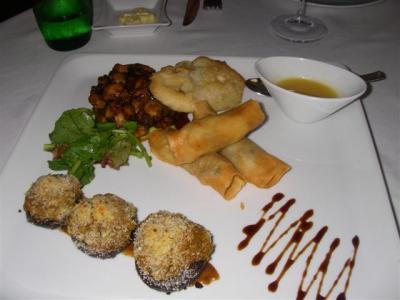
We shared one main course, grouper in a rich, creamy coconut milk and curry sauce with broccoli on the side. For dessert we got passionfruit mousse. Everything was so good. We had been craving a really, really good meal like that ever since we left Bonaire. We even asked to thank the chef in person for such a great meal.
After lunch, we went to Casco Viejo to go sightseeing. The taxi took us through a neighborhood of all high rises, then turned into a very third world part of town. This area was reminiscent of Colon in that it was probably once nice, but is now incredibly run down. The streets were narrow and there was a lot of pedestrian traffic. As we drove, we crossed an intersection that seemed to mark a neighborhood boundary line. The buildings on both sides of the street were of the same era, but on the other side of the street, some of the buildings were fully renovated and beautiful. We must have officially entered the neighborhood of Casco Viejo.
After Henry Morgan burned down Panama City in 1671, the leaders decided to move the city to a rocky peninsula 8 kilometers southwest that was surrounded by reefs, thus making it more protected from sea attack. The town went through many ups and downs over the years, but never really grew much. In 1904, Casco Viejo was all of Panama City. After 1904, as Panama City grew into a huge and bustling city, Casco Viejo became a neglected slum. Today, the area is considered a Unseco world heritage site and the area is being gentrified.
As we continued on, the neighborhood suddenly reminded us of Siracusa almost all the buildings were very old, probably from the 17th and 18th centuries. Many were fully restored to the glory of their heyday and were beautiful. Others were abandoned and had trees growing out of the middle of the foundations and out through the windows. And there was everything in between. We had asked to be dropped off at the Panama Canal Museum. The driver passed by the museum and pointed it out to us, then dropped us off at the esplanade a few blocks away, encouraging us to walk around and enjoy the beautiful scenery before going into the museum.
The esplanade is on top of the walls built to protect the city. It leads around the rocky point. Ferdinand de Lesseps fondly talked about taking walks along this walkway when he came to Panama City shortly before construction on the canal started. Part of the esplanade is covered in a lattice and there is bougainvillea growing up overhead to provide greenery and some shade. Part of it is open. Along the walkway there were several Kuna Indians selling molas, as well as a few other vendors selling typical low end tourist mementos. The views of Panama City are spectacular. Note the gothic style stone balcony behind Eric that has probably stood there for almost 400 years.
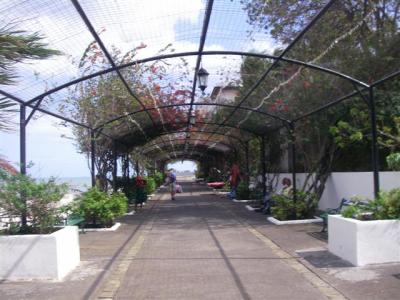
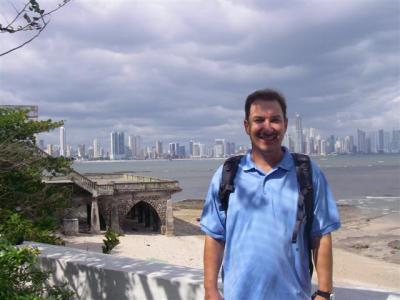
There are also nice views of the causeway and islands attached to the causeway. From the right vantage point, Panama City’s bay could easily be mistaken for San Diego Bay. San Diego also has a bridge that connects an island to the mainland, with a skyline full of new hi-rises on the mainland. As we looked out towards the islands, we noticed that the wind was screaming and the waves in the bay were big. We were glad we weren’t on the boat right then it would definitely feel like we were at sea with such big waves.
The tide was low, and lots of rocks were sticking up out of the water. We could see the appeal of building here. A boat coming in at high tide would be grounded once the tide went down. A boat coming in at slack tide would likely hit a rock lurking just below the surface and sink. And at low tide, they simply couldn’t get close enough to fire the canons.
The walkway ended at a small town square with an obelisk topped by a rooster and busts of five men who were important to Panama’s history, including de Lesseps. There was also a small grassy area and another statue at the other end of the grass.
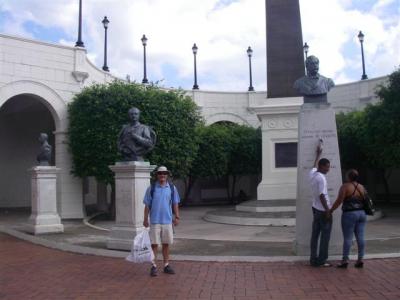
From there, we walked the few blocks to the museum. We were entertained by the buildings. Most of the ones that haven’t been fixed up are in really bad shape and look like they are beyond repair. But even these dilapidated structures show signs of their former glory, with impressive styles and beautiful appointments. Several buildings were in the process of being rehabilitated. The completed buildings are spectacular, and it is hard to believe it is possible to make such a run down shell into something so nice. These rehab projects must take a tremendous amount of money and work. But, what entertained us most was seeing the dilapidated buildings side by side with the newly renovated ones. It is such a striking contrast and probably adds a lot to the area’s character.
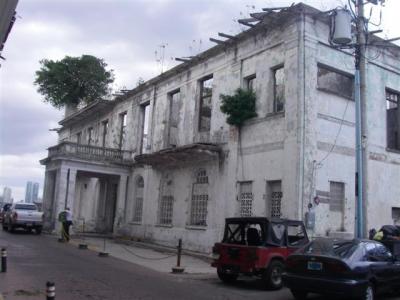
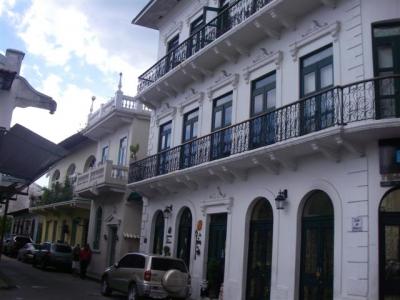
We found an ice cream shop on the way and sampled basil ice cream for the first time. It definitely tastes like basil. It is not very sweet and is definitely a different kind of taste. We only got a single small bite each, and it wasn’t really enough to decide if we liked it or not.
We came to the main town square, a cobblestones open area dotted with trees, named Plaza de la Independencia because it is where Panama declared its independence from Colombia in 1903. On one side is a big church, Iglesia de San Jose. Inside is a golden altar that is about the only thing of value that Henry Morgan didn’t take when he sacked the city. The altar was moved to the church here when the city was moved. We didn’t go in.
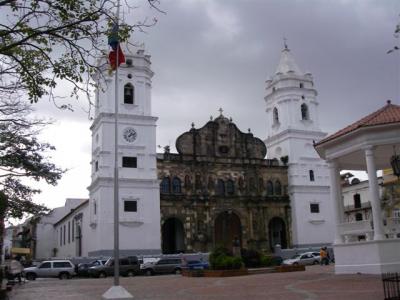
On another side of the park is the Palacio de las Garzas, where the President of Panama lives. We expected there to be a slew of security all around the place to protect the president, but there were just a couple of guards about. We didn’t even attempt to go in there.
The museum is on the third side of the plaza. It was originally built as a hotel, the hotel de Lesspes stayed in when he came to Panama on the visit previously mentioned. He subsequently bought the hotel and turned it into the construction headquarters. It is fully restored and looks just beautiful.
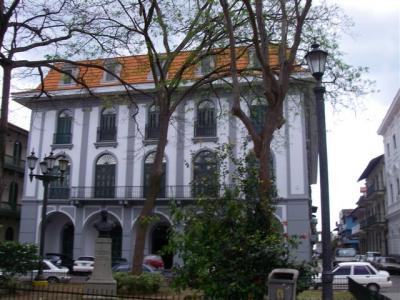
Lonely Planet had said the signs are only in Spanish, but that English audio guides are available. We were sad to find out the audio guides are broken. The museum is well laid out and really interesting, but, like the coffee museum in Guadeloupe, would have gotten more out of it if the signs were in English. We can certainly read in Spanish better than French, but it still requires a lot of concentration and effort and we mentally tired out quicker than we normally do at a museum.
The first floor is mostly devoted to the history of the canal building, most of which we had already learned in reading the assorted histories we have come across. We did learn some new stuff, though. Enough dirt was moved during the construction to build 63 pyramids the size of the pyramids at Giza. Or, to look at it another way, enough dirt was moved to make the Great Wall of China 60% bigger. That is pretty astronomical!
There is a small exhibit on the indigenous people of the pre-colonial days, including some samples of the solid gold armor they wore for battle. There is also a small exhibit on the history of the Panamanian short cut before the train and canal were built, when a combination of walking/mules and river boats were used to get from one ocean to the other.
The second floor is eclectic. There is an exhibit on life in the early days of the canal construction and the early days of the canal. We were most surprised that the Americans instituted segregation just like in the southern US states, such as separate housing, separate shops and hospitals, etc. In addition to the Jim Crow laws, they even instituted a different pay system. Non-whites were paid in Panamanian issued silver coins. Whites were paid in US issued gold coins, and got a minimum of 4 times more than a non-white worker would be paid for the same job. De-segregation took place in the 1950’s.
There is also large exhibit on the Panamanian money system. Panama does, and always has, issued their own coins. Since American money flowed freely in Panama, it was decided to make their coins the same size and shape as the equivalent US coins to prevent confusion. The two sets of coins are and always were used interchangeably here. Their constitution was not set up to allow the printing of paper money, and they have never bothered to change, which is why they still use US dollars. In 1941, President Arias did have paper money printed, but within 7 days the money was pulled from circulation and destroyed.
There is an exhibit on the technological advancements that came to Panama with the train and canal. Panama was the first place in Central America/Caribbean to get cable laid for morse code, and then, later, the first to get telephones. The assorted technological advancements are detailed through to today. Now the canal is fully computerized. It is strange to think how only 100 years ago things like telephones were state of the art technology here. It’s amazing how much we take technology for granted nowadays.
After we finished at the museum, we decided to head back to the boat. It was starting to get late, and we wanted to be back before dark. As we had anticipated, it was super rocky and uncomfortable on board. We are ready to get moving again. The anchorage here is simply too uncomfortable.

isn’t gold considered a soft metal? I’m not so sure that gold armor would be so great to have on in the field of battle.